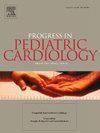Cardiorenal fat, and carotid intima media thickness in children with end stage kidney disease in Fayoum governorate
IF 0.8
Q4 PEDIATRICS
引用次数: 0
Abstract
Background
The fat surrounding the kidney, heart, and increased carotid intima media thickness (CIMT) have been closely related to adverse cardiovascular outcomes in children with end stage kidney disease (ESKD).
Objectives
To evaluate epicardial fat thickness (EFT), perirenal fat thickness (PFT), and CIMT in hemodialysis patients and to assess the risk factors for increasing the thickness of these parameters.
Methods
This case-control study included 60 children with ESKD on regular hemodialysis and 60 apparently healthy children. EFT was measured using two-dimensional echocardiography, whereas CIMT and PFT were measured utilizing neck Doppler and abdominal ultrasound, respectively.
Results
The case group had significantly impaired systolic function with lower ejection fraction (EF) (mean = −0.87 ± 1.3) compared to the control group (mean = 0.33 ± 0.48, p < 0.0001) and impaired diastolic function with Tei index significantly higher in cases (mean = 0.56) compared to controls (0.37). We found a significant increase in EFT, CIMT, and PFT in cases compared to controls (all p < 0.001). We observed significant positive correlations between PFT and duration of hemodialysis (r = 0.412, p = 0.024), serum urea (r = 0.370, p = 0.044), and serum creatinine (r = 0.373, p = 0.042). We found positive correlations between EFT and each of the interventricular septum (IVS) thickness (r = 0.462, p = 0.042) and left ventricular end diastolic diameter (LVEDD) (r = 0.508, p = 0.004).
Conclusion
Children with ESKD who undergo regular hemodialysis have left ventricular systolic and diastolic dysfunction. The EFT, CIMT, and PFT were higher in children with ESKD. PFT was positively associated with duration of hemodialysis, LVEDD, and Tei index. EFT was positively correlated with IVS thickness and LVEDD. Rather than using broad measures of total adiposity, assessments of PFT, CIMT, and epicardial fat are more practical techniques for assessing cardiovascular risk in children with ESKD.
法尤姆省终末期肾病儿童的心肾脂肪和颈动脉内膜中膜厚度
研究背景:终末期肾病(ESKD)患儿肾脏、心脏周围的脂肪和颈动脉内膜中膜厚度(CIMT)的增加与不良心血管结局密切相关。目的评价血液透析患者心外膜脂肪厚度(EFT)、肾周脂肪厚度(PFT)和CIMT,并探讨其厚度升高的危险因素。方法本研究纳入60例定期血液透析的ESKD患儿和60例表面健康的患儿。使用二维超声心动图测量EFT,而使用颈部多普勒和腹部超声分别测量CIMT和PFT。结果与对照组(平均= 0.33±0.48,p < 0.0001)相比,病例组收缩功能明显受损,射血分数(EF)较低(平均= - 0.87±1.3);舒张功能受损,Tei指数显著高于对照组(平均= 0.56)。我们发现,与对照组相比,病例中EFT、CIMT和PFT显著增加(均p <; 0.001)。我们观察到PFT与血液透析持续时间(r = 0.412, p = 0.024)、血清尿素(r = 0.370, p = 0.044)和血清肌酐(r = 0.373, p = 0.042)呈正相关。我们发现EFT与室间隔(IVS)厚度(r = 0.462, p = 0.042)和左室舒张末期内径(LVEDD) (r = 0.508, p = 0.004)呈正相关。结论ESKD患儿经定期血液透析后存在左室收缩和舒张功能障碍。ESKD患儿的EFT、CIMT和PFT较高。PFT与血液透析持续时间、LVEDD和Tei指数呈正相关。EFT与IVS厚度、LVEDD呈正相关。评估PFT、CIMT和心外膜脂肪是评估ESKD儿童心血管风险的更实用的技术,而不是使用广泛的总脂肪测量方法。
本文章由计算机程序翻译,如有差异,请以英文原文为准。
求助全文
约1分钟内获得全文
求助全文
来源期刊

PROGRESS IN PEDIATRIC CARDIOLOGY
PEDIATRICS-
CiteScore
0.90
自引率
11.10%
发文量
69
审稿时长
75 days
期刊介绍:
Progress in Pediatric Cardiology is an international journal of review presenting information and experienced opinion of importance in the understanding and management of cardiovascular diseases in children. Each issue is prepared by one or more Guest Editors and reviews a single subject, allowing for comprehensive presentations of complex, multifaceted or rapidly changing topics of clinical and investigative interest.
 求助内容:
求助内容: 应助结果提醒方式:
应助结果提醒方式:


